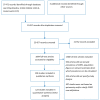Global and regional estimates of COPD prevalence: Systematic review and meta-analysis
- PMID: 26755942
- PMCID: PMC4693508
- DOI: 10.7189/jogh.05.020415
Global and regional estimates of COPD prevalence: Systematic review and meta-analysis
Abstract
Background: The burden of chronic obstructive pulmonary disease (COPD) across many world regions is high. We aim to estimate COPD prevalence and number of disease cases for the years 1990 and 2010 across world regions based on the best available evidence in publicly accessible scientific databases.
Methods: We conducted a systematic search of Medline, EMBASE and Global Health for original, population-based studies providing spirometry-based prevalence rates of COPD across the world from January 1990 to December 2014. Random effects meta-analysis was conducted on extracted crude prevalence rates of COPD, with overall summaries of the meta-estimates (and confidence intervals) reported separately for World Health Organization (WHO) regions, the World Bank's income categories and settings (urban and rural). We developed a meta-regression epidemiological model that we used to estimate the prevalence of COPD in people aged 30 years or more.
Findings: Our search returned 37 472 publications. A total of 123 studies based on a spirometry-defined prevalence were retained for the review. From the meta-regression epidemiological model, we estimated about 227.3 million COPD cases in the year 1990 among people aged 30 years or more, corresponding to a global prevalence of 10.7% (95% confidence interval (CI) 7.3%-14.0%) in this age group. The number of COPD cases increased to 384 million in 2010, with a global prevalence of 11.7% (8.4%-15.0%). This increase of 68.9% was mainly driven by global demographic changes. Across WHO regions, the highest prevalence was estimated in the Americas (13.3% in 1990 and 15.2% in 2010), and the lowest in South East Asia (7.9% in 1990 and 9.7% in 2010). The percentage increase in COPD cases between 1990 and 2010 was the highest in the Eastern Mediterranean region (118.7%), followed by the African region (102.1%), while the European region recorded the lowest increase (22.5%). In 1990, we estimated about 120.9 million COPD cases among urban dwellers (prevalence of 13.2%) and 106.3 million cases among rural dwellers (prevalence of 8.8%). In 2010, there were more than 230 million COPD cases among urban dwellers (prevalence of 13.6%) and 153.7 million among rural dwellers (prevalence of 9.7%). The overall prevalence in men aged 30 years or more was 14.3% (95% CI 13.3%-15.3%) compared to 7.6% (95% CI 7.0%-8.2%) in women.
Conclusions: Our findings suggest a high and growing prevalence of COPD, both globally and regionally. There is a paucity of studies in Africa, South East Asia and the Eastern Mediterranean region. There is a need for governments, policy makers and international organizations to consider strengthening collaborations to address COPD globally.
Figures





Comment in
-
Correlation of Body Mass Index and Oxygen Saturation in Chronic Obstructive Pulmonary Disease Patients at a Tertiary Care Center in Nepal: A Cross-Sectional Study.Int J Chron Obstruct Pulmon Dis. 2023 Jul 11;18:1413-1418. doi: 10.2147/COPD.S412118. eCollection 2023. Int J Chron Obstruct Pulmon Dis. 2023. PMID: 37456913 Free PMC article.
References
-
- World Health Organization. Global Burden of Disease (GBD) 2002 estimates. In: World Health Report 2004. Geneva: WHO, 2004. Available: http://www.who.int/healthinfo/global_burden_disease/estimates_regional_2.... Accessed: 25 November 2015.
Publication types
MeSH terms
LinkOut - more resources
Full Text Sources
Other Literature Sources
Medical
